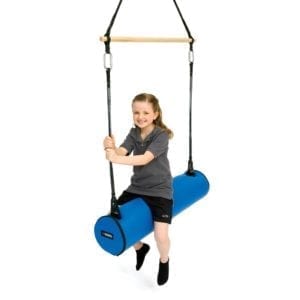Occupational therapists use swings in therapy for a variety of reasons such as strength, balance, and coordination. Swings are also a great tool to address sensory processing as swings provide vestibular (movement) input and some swings also provide proprioceptive (deep pressure) input. Occupational therapists use different types of swings according to what they are targeting in therapy. How are these swings different and more beneficial than typical playground swings you ask? Well, a licensed occupational therapist uses swings in a controlled and safe environment which allows therapists to engage and challenge your child in a variety of body positions and activities that address a variety of skills. Below describes different swings that an occupational therapist might use during therapy:
Platform Swing
A platform swing is a carpeted wooden platform hung from ropes. This type of swing offers tilting movements. An occupational therapist uses this swing when working on balance, core strengthening, correcting postural adjustments, and body awareness. The child can sit, stand, kneel, or lay down on the platform swing. This swing can also address sensory processing as it provides vestibular input.
The buoy ball swing is great for overall strengthening along with balancing reactions for the child during therapy as the child has to hang on to the rope and maintain a seated position with their legs wrapped around the ball. The swing also targets controlled falling/crashing, sensory processing, motor planning, and gross motor skills.
Cuddle Swing
A cuddle swing is a stretchy fabric that resembles a cocoon hanging from the ceiling. This swing surrounds the child which provides vestibular and proprioceptive input to help improve a child’s regulation. This swing helps to soothe and calm a child whether they are overstimulated or seeking out more input to feel regulated.
Bolster Swing
A bolster swing is used by an occupational therapist to improve strength, gross motor skills, coordination, and address sensory processing. This swing can be used to place a child in a variety of positions such as sitting, laying on their stomach, or hanging on underneath the bolster.
Source: https://www.southpaw.com/advantage-line-2-in-1-bolster-swing-trapeze-bar.html
T-Swing
This swing looks like an upside down “T” and a child wraps their arms and legs around the barrel to be swung. This swing targets vestibular processing, strength, body awareness, and motor planning.
Sling Swing
This swing is also known as the “prone extension swing” or the “Superman” swing. This is because the child lies on his/her stomach while weight bearing through their arms on the floor. This targets the upper body, neck, and trunk strength. The child can also be swung in all directions to address sensory processing.
Trapeze Swing
This swing targets upper body and core strength as a child hangs on to the trapeze bar with their hands and lift their legs up to swing. This swing is also used to provide vestibular input to address sensory processing.
Acrobat Swing
The acrobat swing is made up of four colorful layers of Lycra that provides varying resistance layer by layer. This swing provides vestibular and proprioceptive input that is great for developing body awareness and motor planning. This swing can also have a calming effect due to the sensory input a child receives in it. Having the child crawl through the layers works towards improving strength and stability.
One of the best things about utilizing swings in therapy is that kids love them and have no idea they are even doing work! Swings are fun and beneficial tools that are frequently used by pediatric occupational therapists. Contact Chicago Occupational Therapy or call (773) 980-0300 to learn more about our services and how we can help your child flourish and grow.


